Car detailing is a meticulous process of enhancing and maintaining a vehicle’s appearance, both inside and out. It involves thorough cleaning, restoration, and protective treatments to preserve the car’s condition and aesthetics, ensuring a like-new look and feel. Regular detailing not only boosts a car’s visual appeal but also protects its surfaces from damage, making it a vital part of car care and maintenance.
1.1 What is Car Detailing?
Car detailing is a thorough process of cleaning, restoring, and enhancing a vehicle’s interior and exterior to achieve a like-new condition. It involves meticulous attention to detail, from washing and polishing the exterior to vacuuming, sanitizing, and conditioning the interior. Detailing also includes specialized treatments like paint correction, ceramic coating, and upholstery cleaning. The goal is to preserve the vehicle’s appearance, protect its surfaces, and maintain its overall value.
1.2 Importance of Regular Car Detailing
Regular car detailing is essential for maintaining a vehicle’s appearance and protecting its surfaces from damage. It prevents paint fade, reduces wear and tear on interior materials, and removes contaminants that can cause long-term harm. Detailing also improves hygiene by sanitizing surfaces, eliminating odors, and creating a cleaner environment for passengers. Additionally, a well-detailed car retains its value better and leaves a positive impression, making it a worthwhile investment for car owners who take pride in their vehicles.

Exterior Car Detailing
Exterior car detailing involves thorough washing, paint correction, polishing, and applying protective layers to enhance appearance and shield against environmental elements, ensuring a pristine finish.
2.1 Car Washing and Drying Techniques
Proper car washing involves using mild detergents and soft sponges or microfiber towels to avoid scratching the paint. Rinse thoroughly to remove dirt and soap residue. Drying with a microfiber cloth or chamois prevents water spots. Avoid circular motions, as they can create swirl marks. Regular washing maintains the vehicle’s exterior condition and protects the paint from contaminants. Drying techniques ensure a spot-free finish, enhancing the car’s overall appearance and preserving its protective layers.
2.2 Paint Correction and Polishing
Paint correction and polishing are advanced techniques to restore a vehicle’s paintwork by removing imperfections like scratches, swirl marks, and oxidation. Polishers, such as rotary or dual-action tools, are used with specialized compounds to smooth and refine the paint surface. This process enhances gloss, clarity, and color depth; Proper polishing requires skill to avoid over-correction, which can damage the clear coat. The result is a flawless, showroom-like finish that protects the paint and maintains the car’s aesthetic value over time.
2.3 Wheel and Tire Cleaning
Wheel and tire cleaning is essential for maintaining a vehicle’s overall appearance. It involves removing grime, brake dust, and tar using specialized brushes and cleaners. Alloy wheels are cleaned with acid-free products to prevent damage, while tires are scrubbed to eliminate embedded dirt. After cleaning, tires are often dressed to restore their shine and protect against cracking. Regular cleaning prevents corrosion and ensures a sleek, well-maintained look, enhancing both functionality and aesthetics of the car’s exterior.
2.4 Exterior Trim Restoration
Exterior trim restoration focuses on reviving faded or oxidized exterior plastic and chrome components. Techniques include cleaning with specialized products, such as trim restorers or ceramic-infused solutions, to remove grime and restore original shine. Protective coatings or waxes are applied to prevent future fading and damage. Regular maintenance ensures trim remains vibrant, enhancing the car’s overall exterior appearance and protecting against environmental factors like UV rays and pollutants.
2.5 Applying Protective Layers (Wax, Ceramic Coating)
Protective layers like wax or ceramic coating are essential for safeguarding your car’s exterior. Wax provides a barrier against UV rays, dirt, and minor scratches, offering a glossy finish. Ceramic coating, more durable, repels water, contaminants, and UV damage, lasting longer than wax. Both are applied after detailing to maintain the paint’s health and appearance. Regular reapplication ensures ongoing protection, keeping your car looking pristine and preserving its value over time.

Interior Car Detailing
Interior detailing transforms your car’s cabin by deep cleaning upholstery, carpets, and surfaces. It involves vacuuming, sanitizing, and deodorizing to create a fresh, hygienic environment, enhancing comfort and longevity.
3.1 Vacuuming and Cleaning Interior Surfaces
Vacuuming is the first step in interior detailing, removing dirt and debris from seats, carpets, and crevices. Use a detailing brush to gently agitate fibers. For surfaces, use microfiber cloths and pH-neutral cleaners to avoid damage. Pay attention to high-touch areas like the dashboard and console. Glass surfaces should be cleaned with ammonia-free products to prevent streaks. This process ensures a fresh, clean, and hygienic interior environment, enhancing both comfort and aesthetic appeal for drivers and passengers alike.
3.2 Cleaning Dashboard and Interior Panels
Cleaning the dashboard and interior panels involves using a microfiber cloth and a gentle cleaning solution to remove dust, dirt, and grime. Avoid harsh chemicals to prevent damage to materials. Use a soft-bristle brush to clean vents and crevices. For stubborn stains, apply a small amount of solution to the cloth, not directly to the surface. Gently wipe in one direction to avoid scratches. Regular cleaning maintains the interior’s appearance and prevents degradation from UV exposure, leaving surfaces polished and protected. Consistency is key for a pristine interior.
3.3 Sanitizing and Deodorizing the Interior
Sanitizing and deodorizing the interior involve eliminating bacteria, odors, and allergens for a fresh, clean environment. Use a disinfectant spray on surfaces like seats, door panels, and consoles, ensuring thorough coverage. For odors, apply a deodorizer or ozone spray, letting it sit before ventilating the car. Natural air fresheners or essential oils can also neutralize unpleasant smells. Regular sanitization prevents germ buildup and leaves the interior smelling clean and inviting, enhancing comfort and driving experience while maintaining hygiene and aesthetics.
3.4 Upholstery and Carpet Cleaning
Upholstery and carpet cleaning are essential for maintaining a clean and hygienic interior. Start by vacuuming deeply to remove dirt and debris. For stains, use a fabric cleaner or upholstery shampoo, gently scrubbing with a soft-bristle brush. Avoid soaking fabrics to prevent damage. For tough stains, apply a stain remover and let it sit before rinsing. Finish by applying a fabric protector to repel future stains and spills. Regular cleaning extends the life of upholstery and carpets, keeping them looking fresh and vibrant.
3.5 Glass Cleaning and Tinting
Glass cleaning involves using specialized products to remove streaks, smudges, and contaminants for optimal visibility. Use a glass cleaner with a microfiber cloth to ensure a spotless finish. For tinting, apply a high-quality window film to block UV rays, reduce glare, and enhance privacy. Proper tinting improves the car’s aesthetics and protects the interior from fading. Regular cleaning and maintenance of glass surfaces are crucial for safety and visual appeal, ensuring a clear view while driving and preserving the tint’s durability.
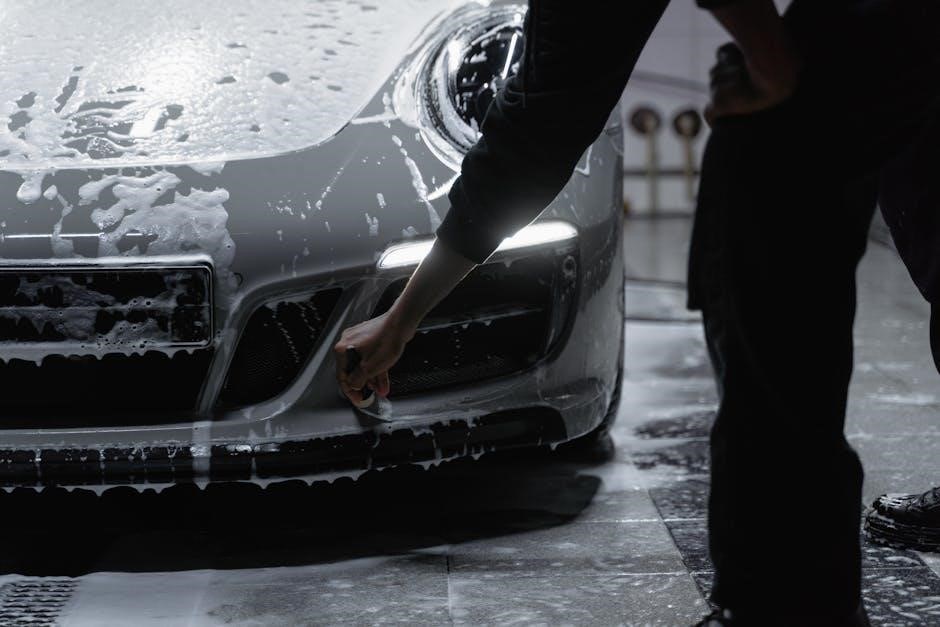
Advanced Car Detailing Techniques
Advanced techniques include specialized methods like ceramic coating, headlight restoration, and engine bay detailing. These processes require precision tools and expertise to enhance protection, appearance, and longevity.
4.1 Ceramic Coating Application
Ceramic coating application is an advanced detailing technique that provides a durable protective layer on a vehicle’s exterior surfaces. It enhances gloss and shields against contaminants, UV damage, and minor scratches. The process involves thoroughly cleaning and preparing the surface before applying the coating, which bonds with the paint for long-lasting protection. Once cured, ceramic coatings offer hydrophobic properties, making maintenance easier. Regular touch-ups ensure the coating’s effectiveness, preserving the vehicle’s appearance over time.
4.2 Headlight Restoration
Headlight restoration is a process that removes oxidation and haze, restoring clarity and improving visibility. Over time, UV exposure causes headlights to become cloudy, reducing light output. The process involves sanding with progressively finer grits, polishing, and applying a protective coating. This not only enhances safety but also boosts the car’s appearance. Regular maintenance can prevent future damage and avoid costly replacements, ensuring optimal performance and a polished look.
4.3 Engine Bay Cleaning
Engine bay cleaning is a detailed process that involves removing dirt, grime, and oil residue from the engine compartment. Using specialized degreasers and pressure washing, the engine and surrounding components are thoroughly cleaned. This not only improves the appearance of the engine bay but also helps prevent damage from corrosive substances. Regular cleaning can enhance performance and make future maintenance easier. Proper protection, such as dressing, is applied to keep the area looking clean and protected from the elements.
4.4 Trim Wrapping and Protection
Trim wrapping and protection are essential for preserving the appearance and longevity of a vehicle’s exterior trim. This process involves applying protective materials, such as vinyl wraps or paint protection film (PPF), to prevent damage from UV rays, fading, and physical abrasions. Properly wrapped trim maintains its original finish and resists environmental wear. Temporary wraps provide flexibility, while permanent solutions offer long-lasting protection. Professional application ensures a seamless finish and enhances the car’s overall aesthetic appeal, making it a key step in advanced detailing techniques.
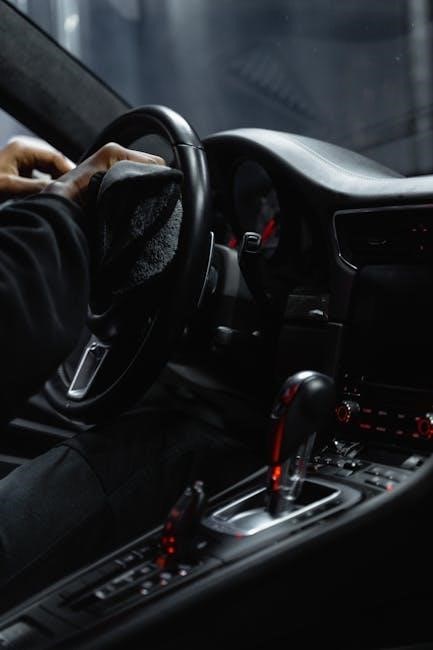
Car Detailing Maintenance Tips
Regular maintenance is key to preserving your car’s detailing results. Establish a routine that includes weekly washes, interior cleanups, and protective layer replenishment to maintain the vehicle’s pristine condition and prevent deterioration from environmental factors.
5.1 Regular Maintenance Schedule
A well-structured maintenance schedule ensures your car stays in top condition. Start with weekly exterior washes using mild detergents and microfiber towels to prevent scratches. Dry thoroughly to avoid water spots. Every two weeks, vacuum the interior and wipe down surfaces. Monthly, apply a protective layer like wax or ceramic coating to the paint and clean the glass. For upholstery, use fabric or leather cleaners as needed, and sanitize high-touch areas regularly to maintain hygiene and freshness throughout the vehicle.
5.2 DIY vs Professional Detailing
DIY detailing offers cost-effectiveness and flexibility, allowing car owners to maintain their vehicles at home. However, it requires time, effort, and proper techniques to avoid damage. Professional detailing provides expert results, using high-quality tools and products for a superior finish. While DIY is budget-friendly, professionals handle complex tasks like paint correction and ceramic coating more effectively. Choose DIY for routine maintenance, but opt for professionals for deep, long-lasting results and convenience.

Safety Precautions and Best Practices
Always wear protective gear and use eco-friendly products. Avoid harsh chemicals and test products on small areas first to prevent damage and ensure safety.
6.1 Avoiding Damage During Detailing
To prevent damage, use microfiber towels and soft brushes. Avoid high-speed buffers on delicate surfaces and work in shaded areas to prevent overheating. Test products on small, inconspicuous areas first. Use gentle cleaning agents and avoid harsh chemicals. Regularly rinse tools to remove debris. For paint correction, use low-speed polishers with light pressure. Never use household cleaners, as they can strip protective layers; Always follow product instructions and detail in a clean, dust-free environment to ensure safe and effective results.
6.2 Using Eco-Friendly Products
Eco-friendly detailing products are essential for reducing environmental impact. Opt for biodegradable cleaners and non-toxic formulas that are safe for surfaces and the planet. Waterless car washes and microfiber towels minimize water usage. Plant-based polishes and natural waxes are sustainable alternatives to harsh chemicals. Always read labels to ensure products meet eco-certifications. Proper disposal of waste and excess product is crucial. By choosing eco-friendly options, you promote sustainability while maintaining your car’s appearance responsibly.
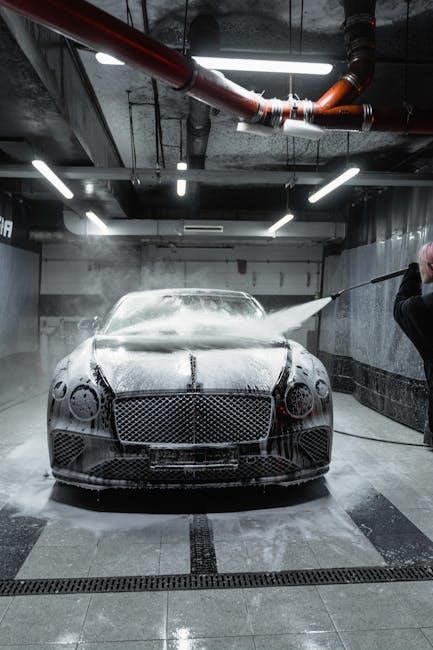
The Cost of Car Detailing
Car detailing costs vary based on services, location, and vehicle size. Basic packages start around $50, while premium detailing can exceed $200. Eco-friendly or advanced treatments may increase prices.
7.1 Average Prices for Car Detailing Services
Car detailing prices vary widely depending on the services and vehicle size. Basic detailing typically costs between $50 and $125, while premium services can range up to $200. Additional treatments, such as paint correction or ceramic coating, may add $100 to $300. Eco-friendly or advanced options often increase the price. Location, expertise, and product quality also influence costs. Budget-friendly options are available, but high-end detailing can exceed $500 for luxury vehicles. Always compare packages and reviews to find the best value for your needs.
7.2 DIY vs Professional Cost Comparison
DIY car detailing is cost-effective, with basic kits costing $50–$100, but requires time and effort. Professional detailing averages $150–$300, offering superior results and convenience. DIY suits maintenance and minor touch-ups, while professionals handle deep cleaning and advanced treatments. Choose DIY for budget-friendly, routine care, or professionals for premium results and time-saving benefits. Costs vary based on vehicle size, condition, and service complexity, making it important to weigh budget and desired outcomes when deciding between the two options.

Marketing Your Car Detailing Business
Effective marketing involves showcasing your services online, using Google Ads, social media, and before-and-after photos. Build a strong reputation through customer reviews and referrals to attract clients.
8.1 Attracting Customers
Attracting customers to your car detailing business requires a combination of online and offline strategies. Utilize Google Ads and social media platforms to reach a broader audience. Share high-quality before-and-after photos to showcase your work and build credibility. Offer special discounts or referral programs to encourage word-of-mouth marketing. Partnering with local businesses, such as car washes or auto repair shops, can also help drive traffic to your detailing services. Consistent branding and excellent customer service are key to retaining clients and attracting new ones.
8.2 Online Marketing Strategies
Effective online marketing is crucial for growing your car detailing business. Optimize your Google Ads campaigns to target local customers searching for detailing services. Utilize social media platforms like Instagram and Facebook to share before-and-after photos and tutorials. Implement SEO strategies to improve your website’s visibility for keywords like “car detailing services.” Leverage email marketing to send promotions and tips to subscribers. Engage with your audience by responding to reviews and comments to build trust and loyalty in your brand.
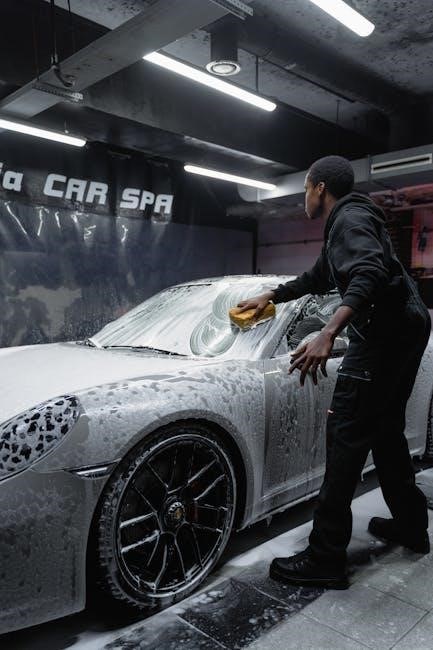
Car Detailing Trends
The car detailing industry is embracing eco-friendly products, advanced ceramic coatings, and mobile detailing services, reflecting a shift toward convenience, sustainability, and cutting-edge technology.
9.1 Current Trends in the Industry
The car detailing industry is evolving rapidly, with a focus on eco-friendly products, advanced ceramic coatings, and mobile detailing services. Many professionals now offer eco-conscious solutions, such as waterless washes and biodegradable cleaners, to reduce environmental impact. Additionally, the rise of mobile detailing brings convenience to customers, allowing services to be performed at home or work. Technology integration, like automated washing systems and AI-driven tools, is also gaining traction, enhancing efficiency and precision in the detailing process.
9.2 Future of Car Detailing
The future of car detailing lies in advanced technologies and sustainability. AI-driven tools and automation are expected to streamline processes, while eco-friendly practices will dominate. Electric vehicle (EV) detailing will grow, focusing on specialized care for EV surfaces. Mobile detailing services will continue to rise, offering convenience. Additionally, demand for long-lasting protective coatings like ceramic and graphene will increase. The industry will also see more integration of smart technologies, such as self-cleaning paints and automated washing systems, making car care more efficient and environmentally friendly.
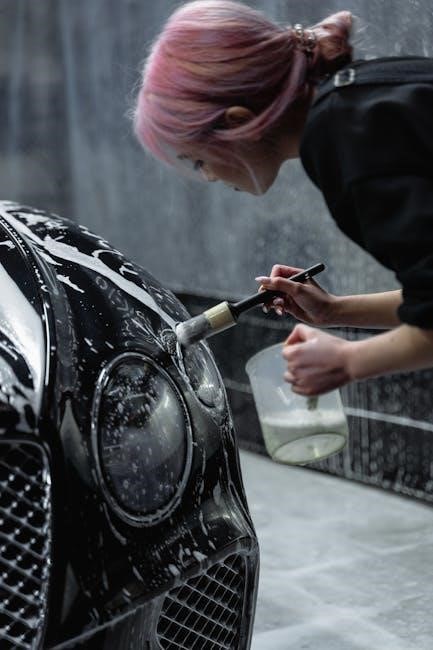
Essential Tools and Products
Essential tools for car detailing include microfiber towels, dual-action polishers, clay bars, and vacuum cleaners. Key products are car wash soaps, waxes, ceramic coatings, and interior cleaners. These tools ensure a flawless finish and long-lasting protection for both exteriors and interiors, making them indispensable for professional and DIY detailing processes.
10.1 Must-Have Tools for Car Detailing
Essential tools for car detailing include microfiber towels for cleaning and drying, dual-action polishers for paint correction, clay bars for removing contaminants, and vacuum cleaners with detailing attachments. Brushes, such as smaller ones for tight spaces, and drying towels are also crucial. Buckets with grit guards help prevent scratches during washing, while pressure washers aid in exterior cleaning. Measuring cups, tar and bug removers, and UV protectants for interiors round out the must-have tools for a professional detailing process.
10.2 Recommended Products for Detailing
Recommended products for detailing include high-quality car wash soaps, microfiber-safe cleaning solutions, and pH-neutral leather cleaners. Ceramic coatings and synthetic waxes protect paint and enhance shine, while glass cleaners ensure streak-free windows. Interior products like fabric cleaners and sanitizing sprays maintain hygiene and freshness. Tire dressings and wheel cleaners keep exteriors looking sharp. Trusted brands like Meguiar’s, Chemical Guys, and Auto Finesse offer reliable solutions for a professional-grade detailing experience.
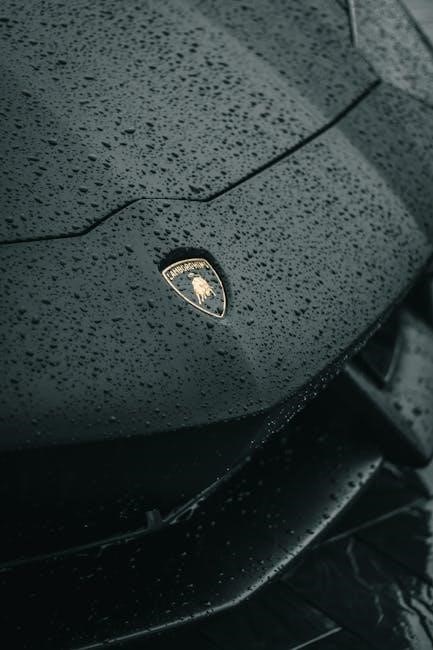
No Responses